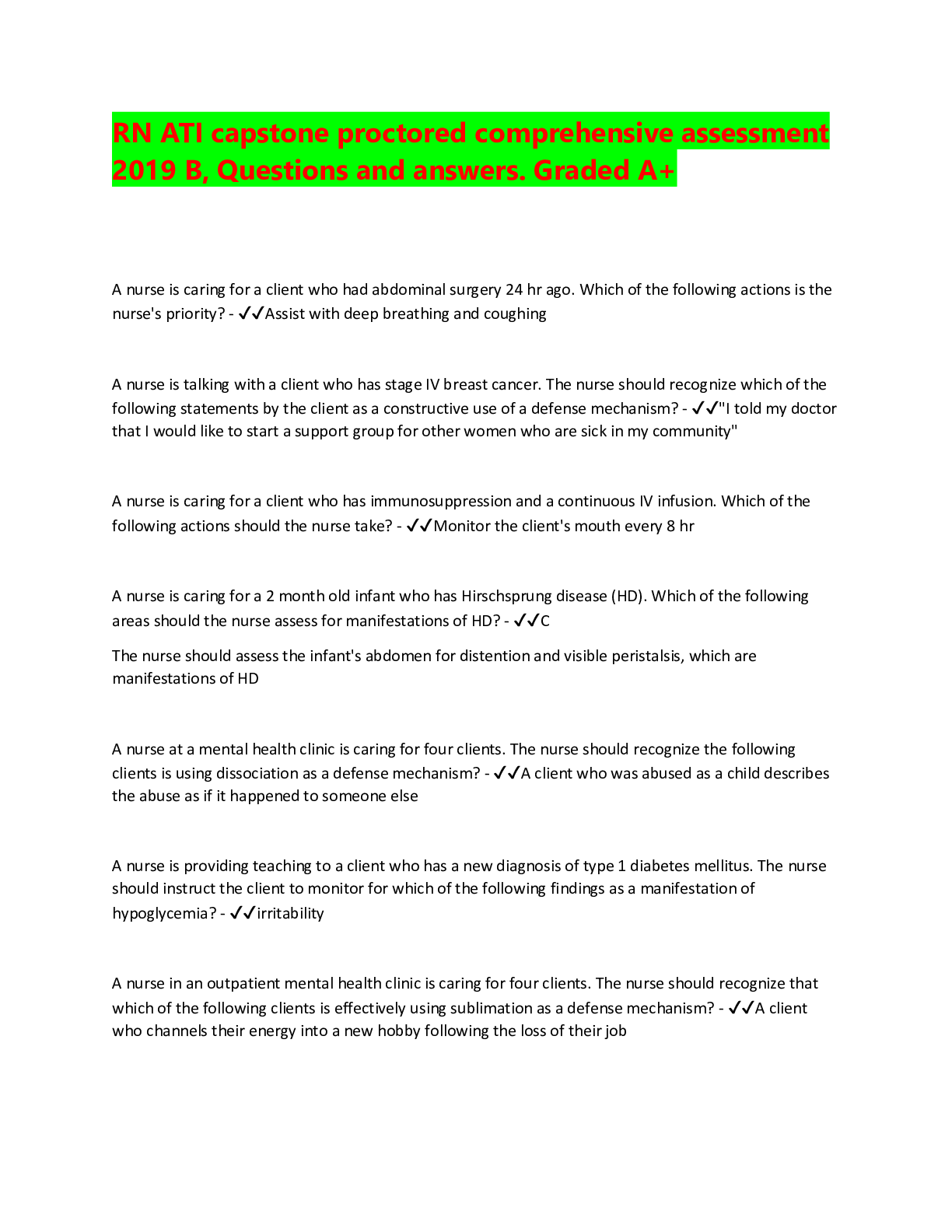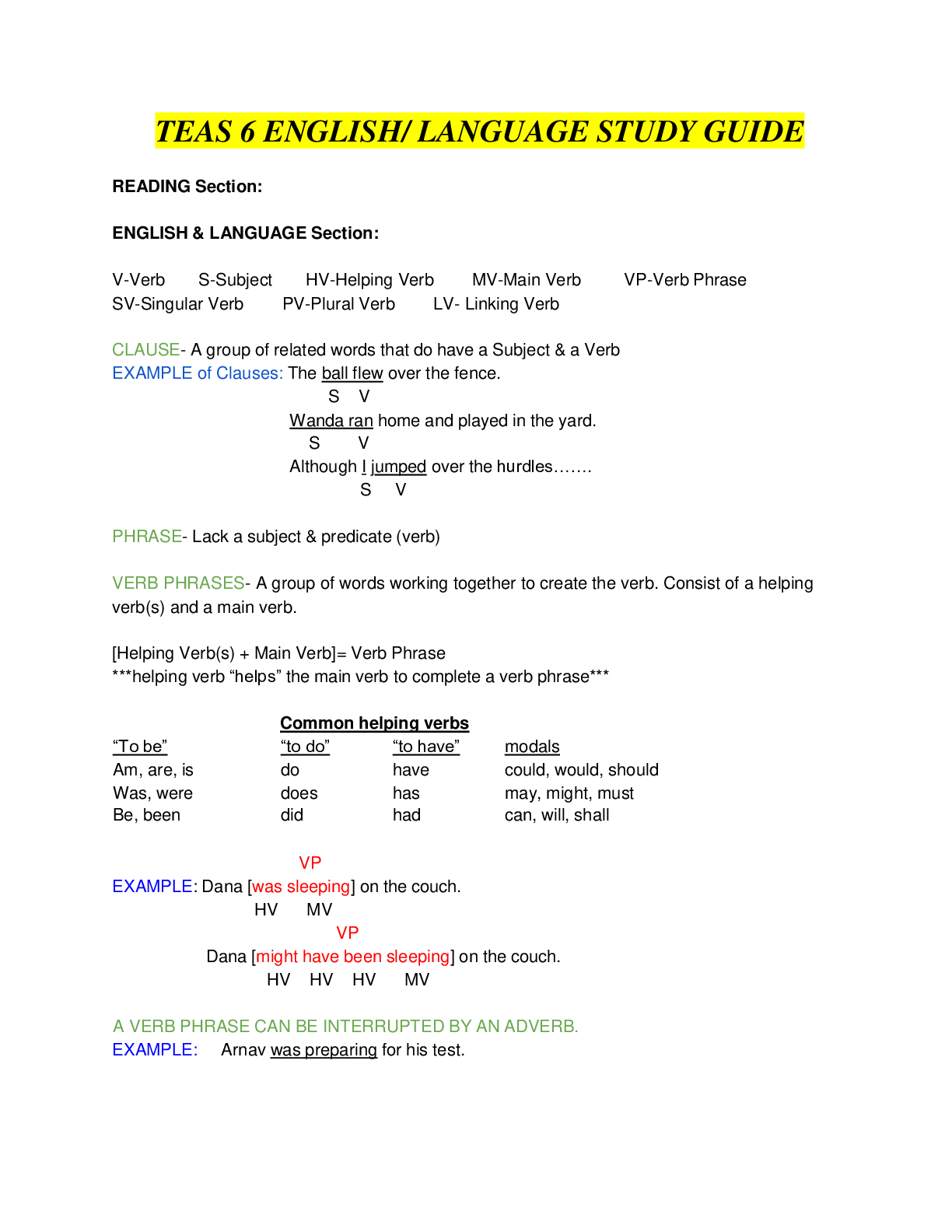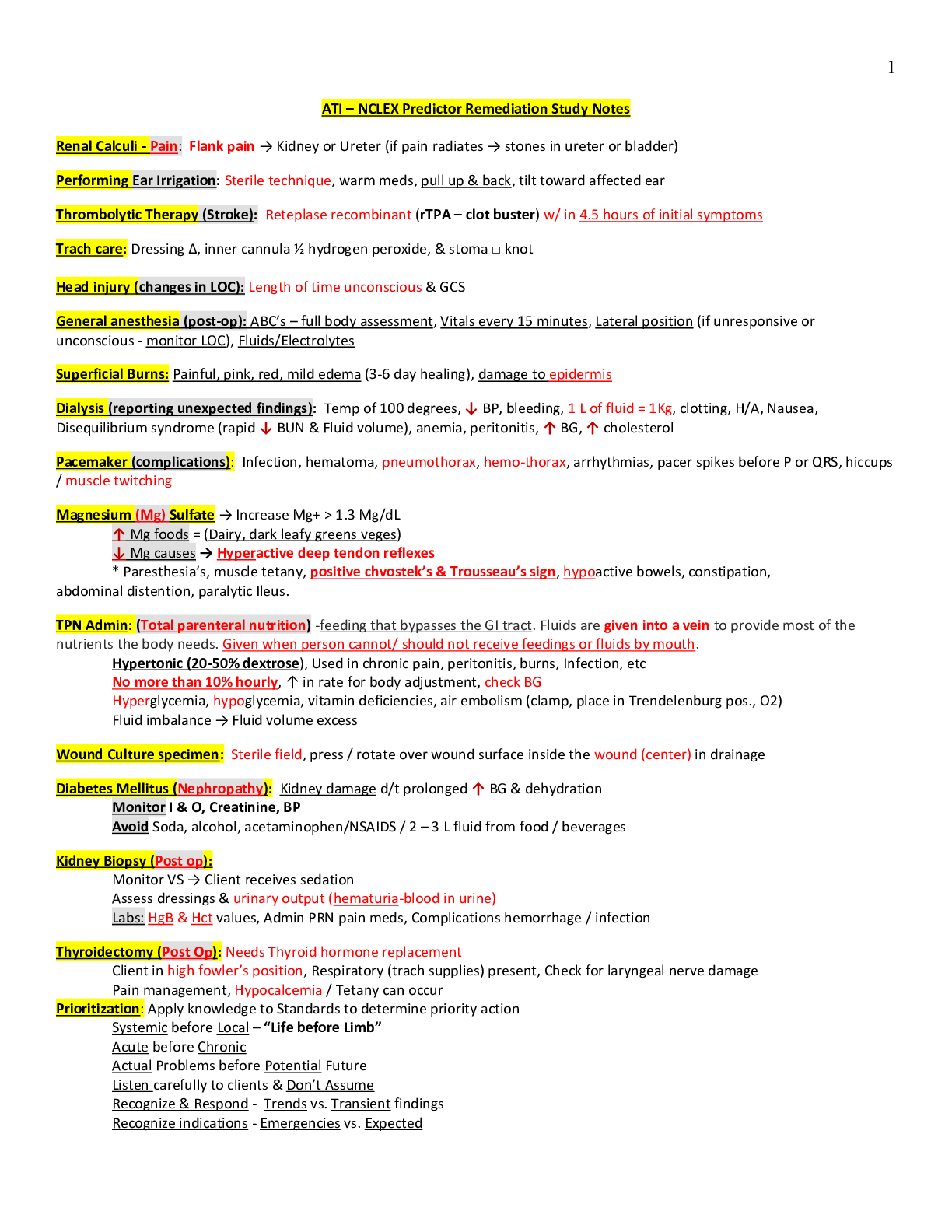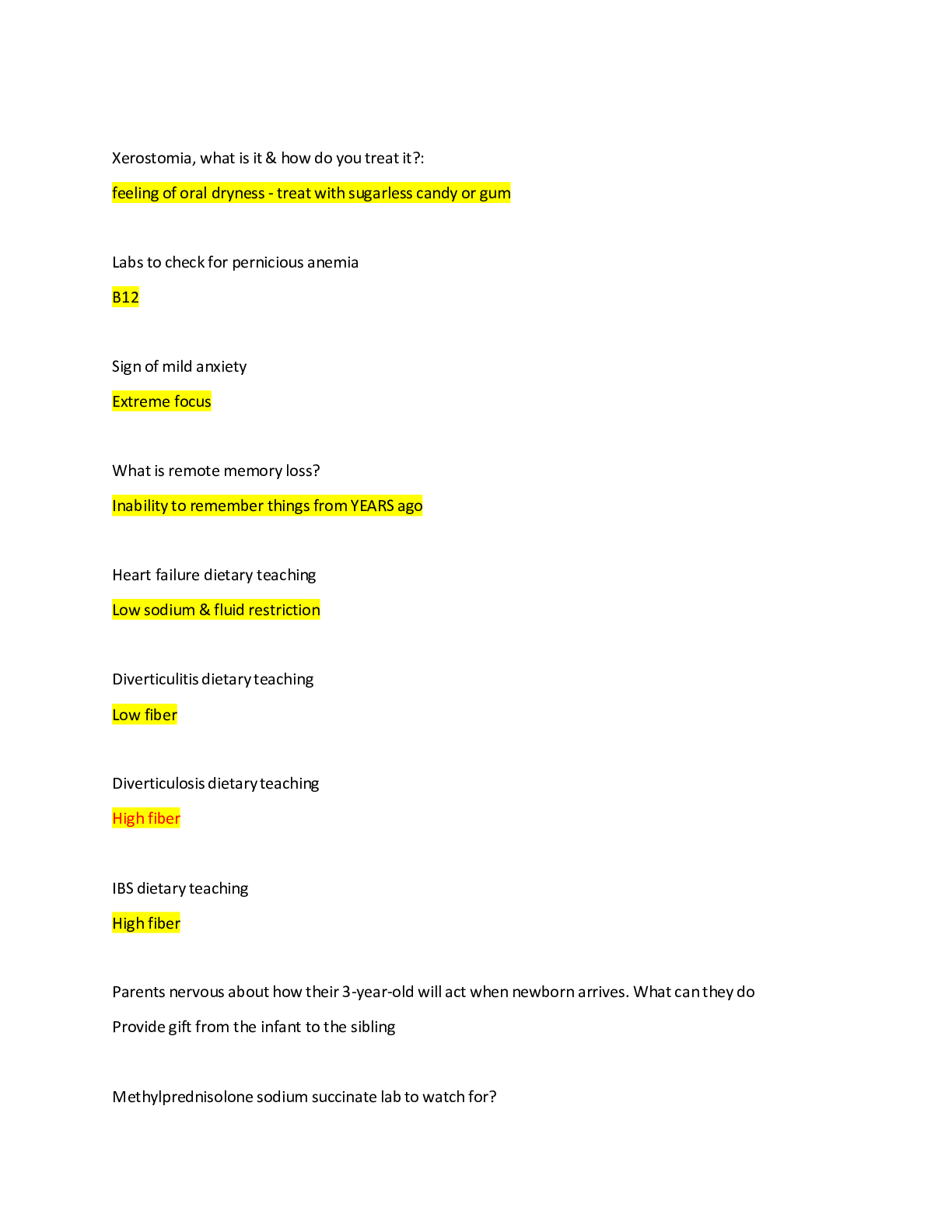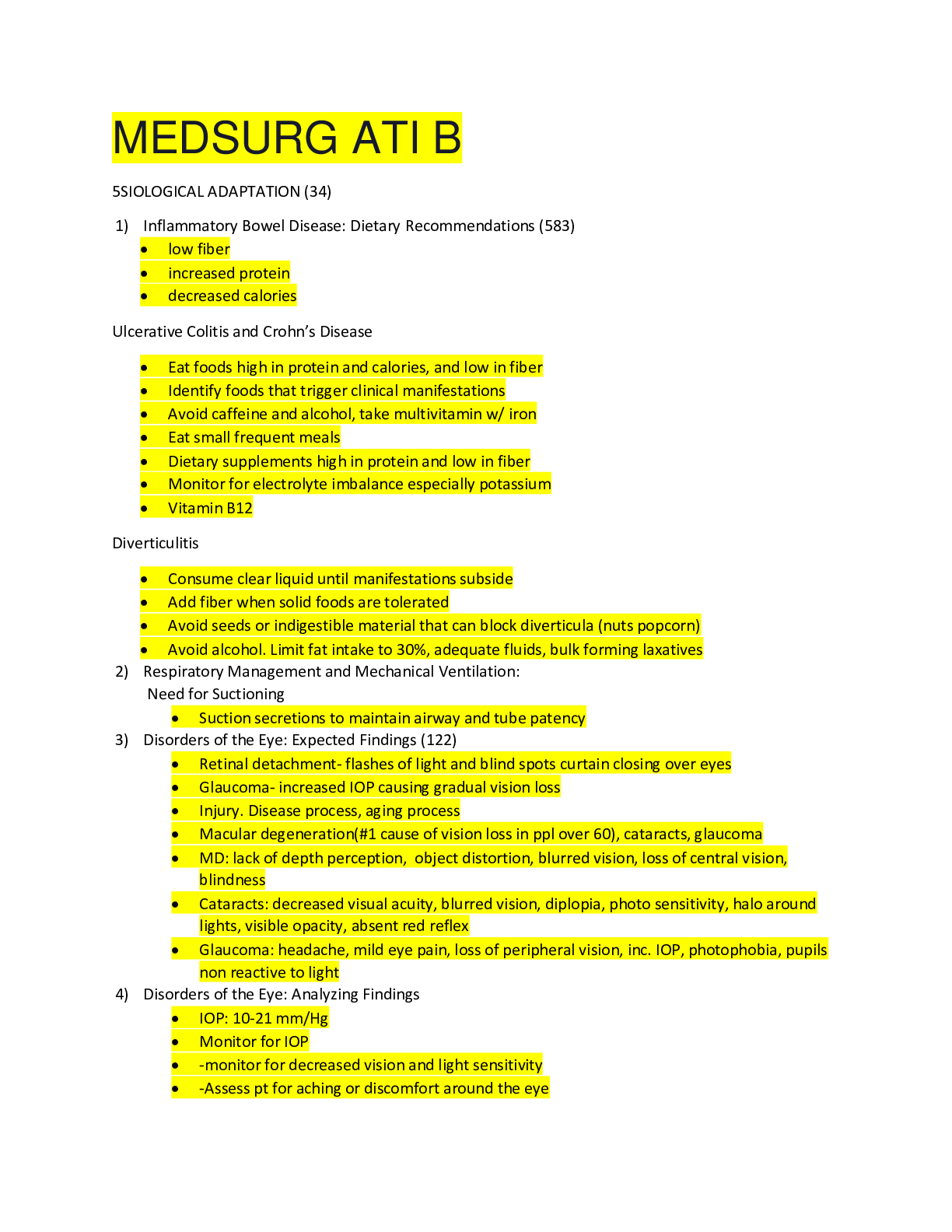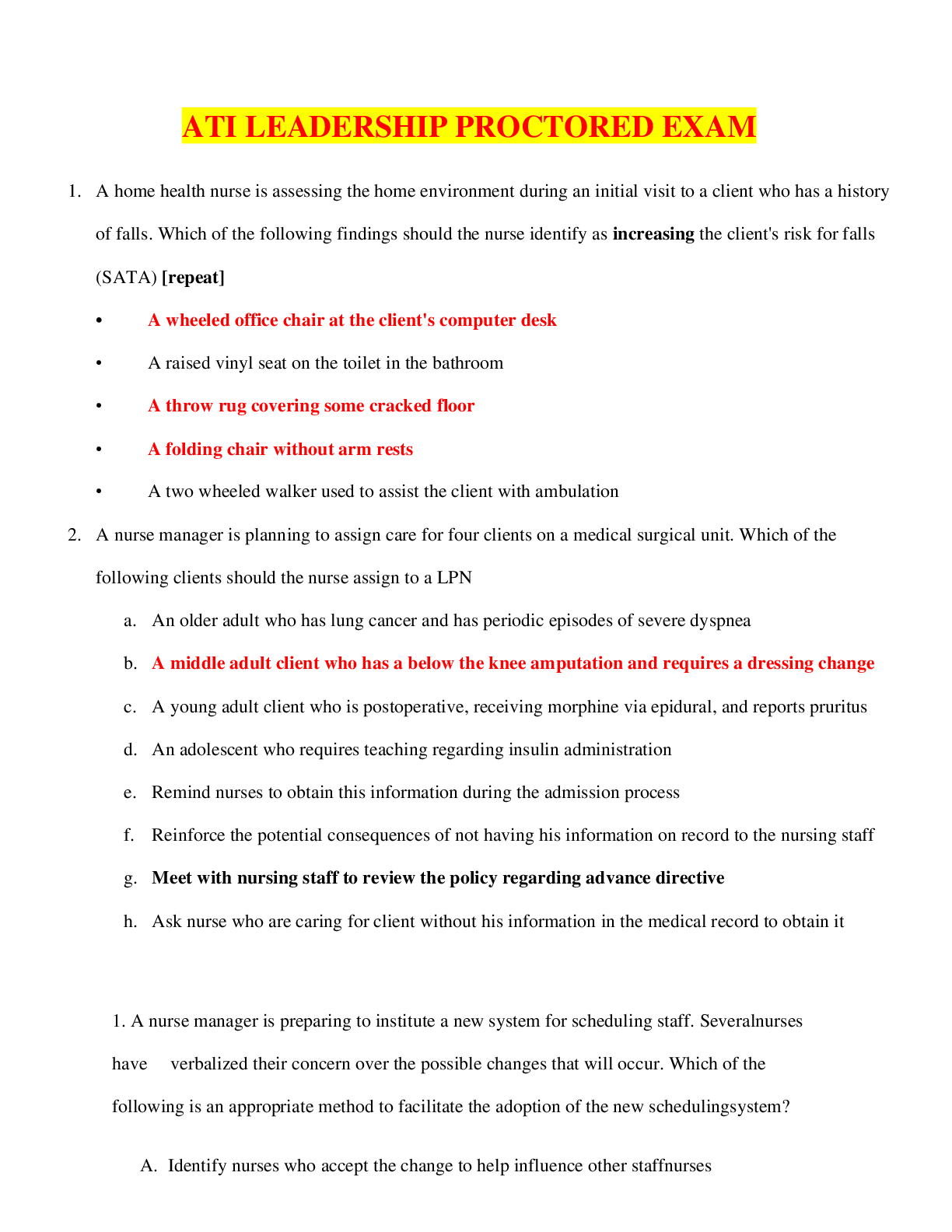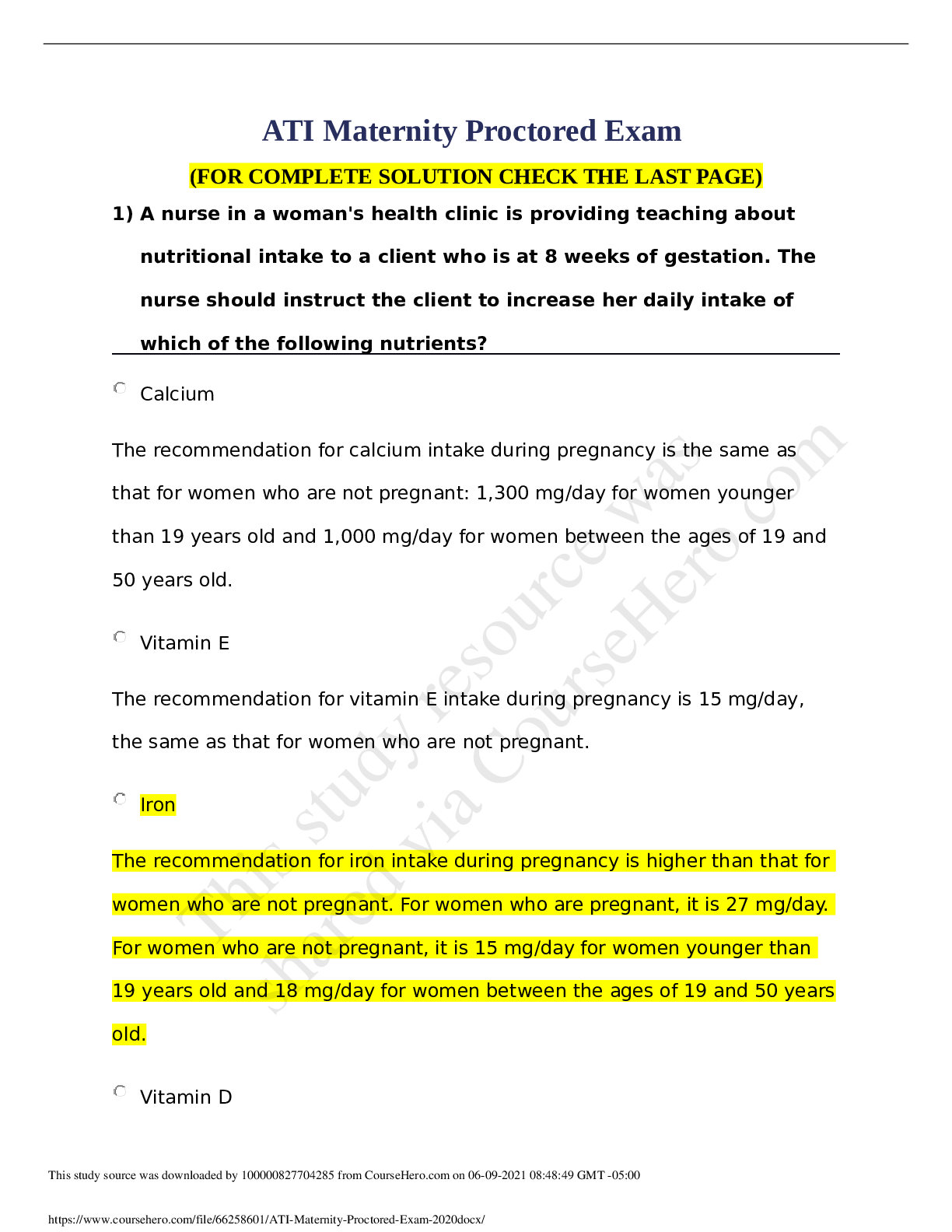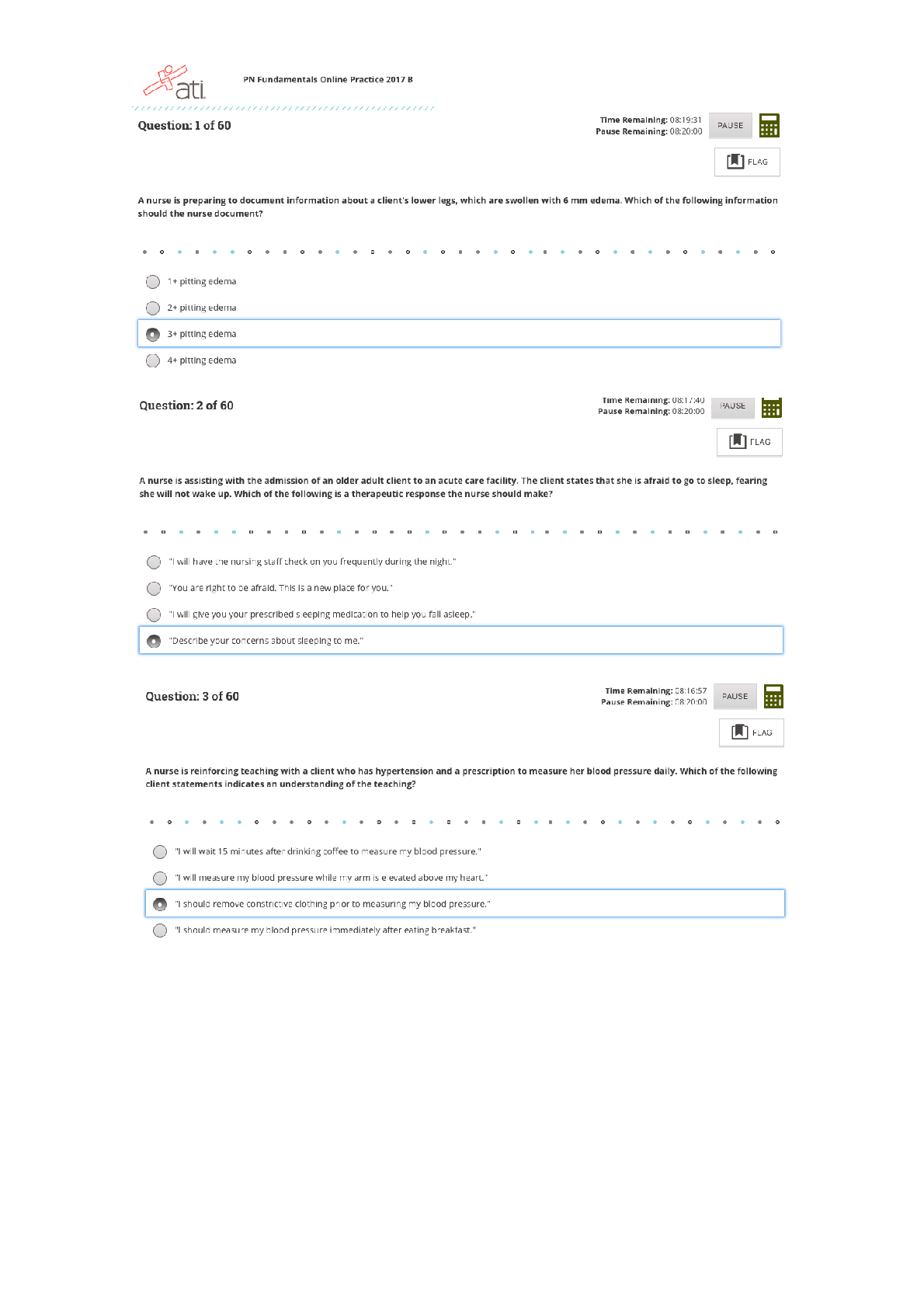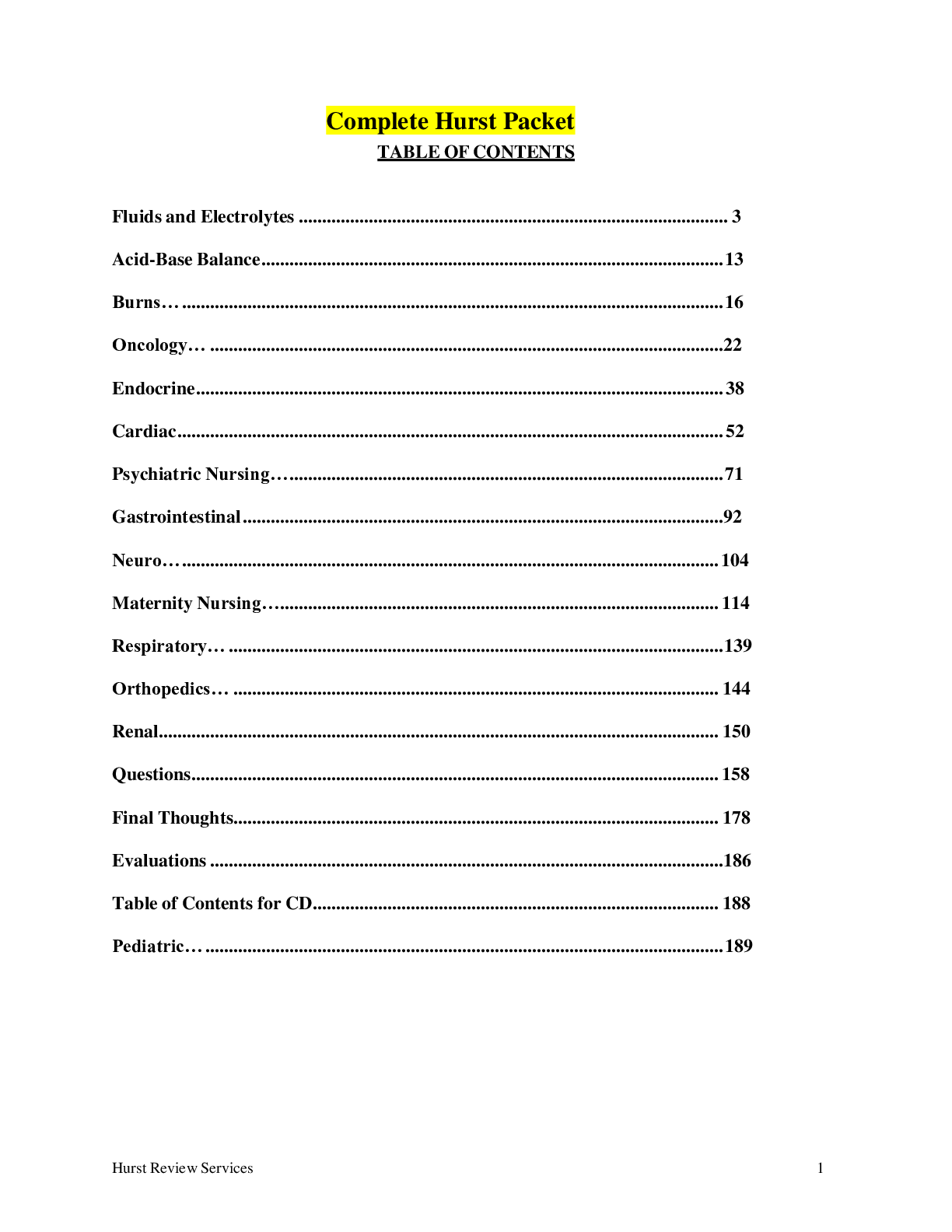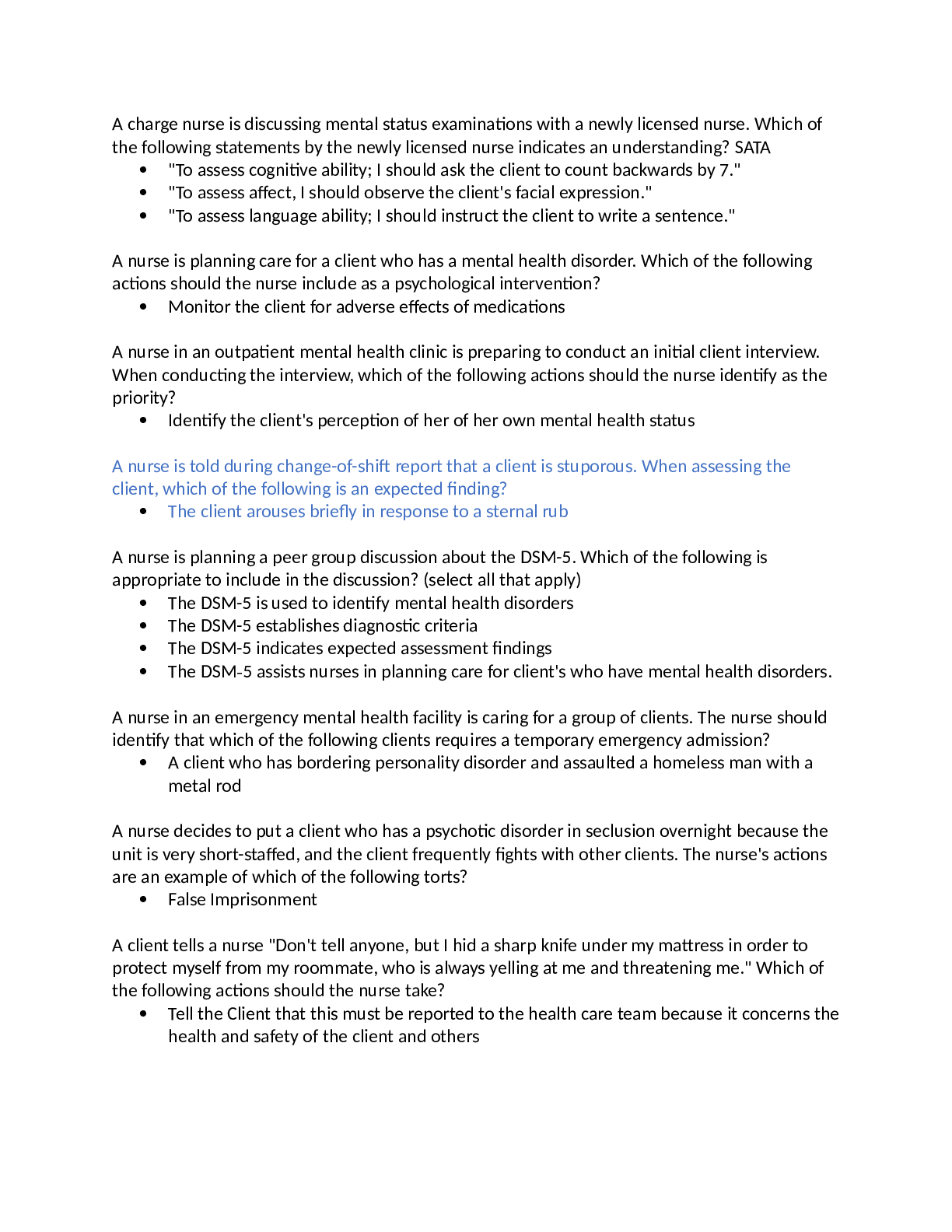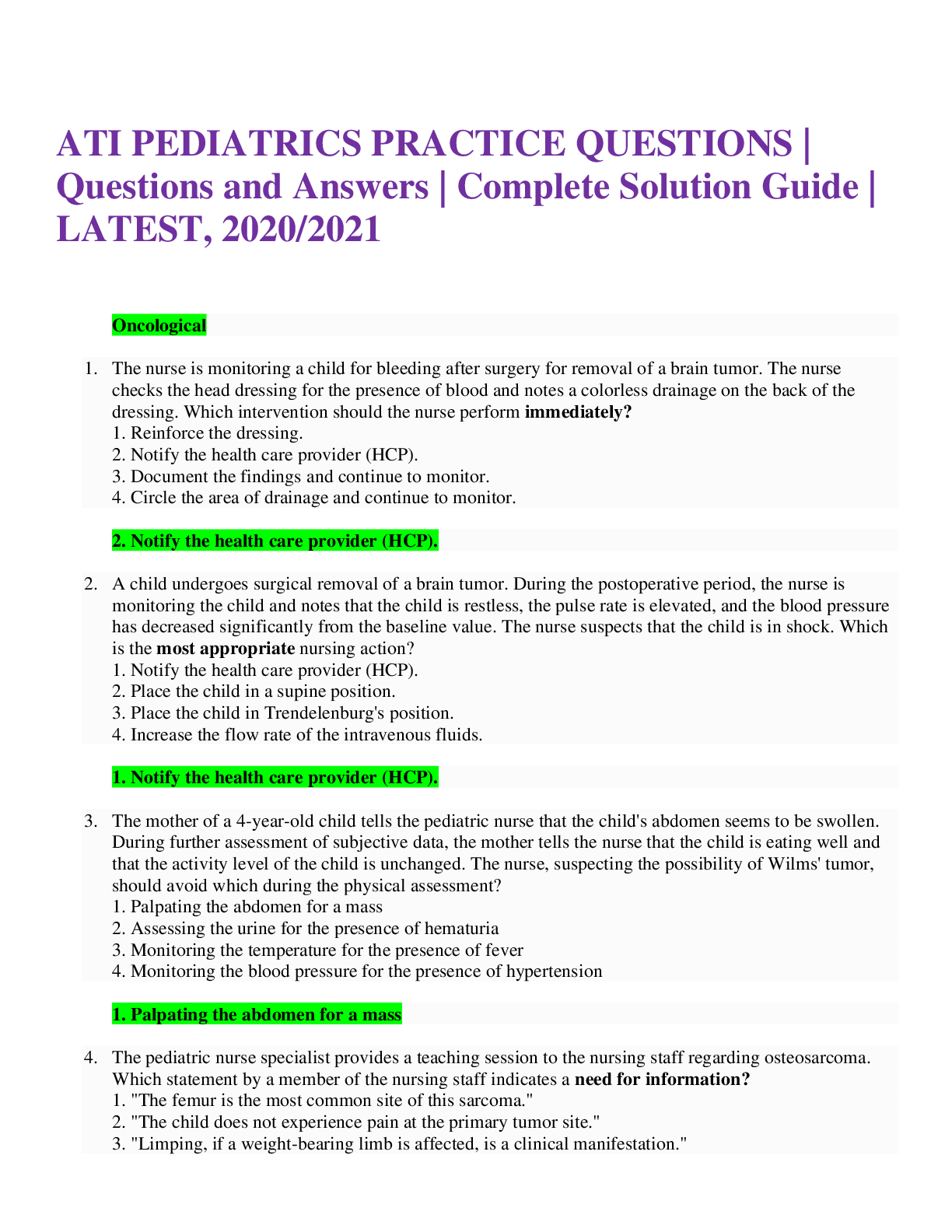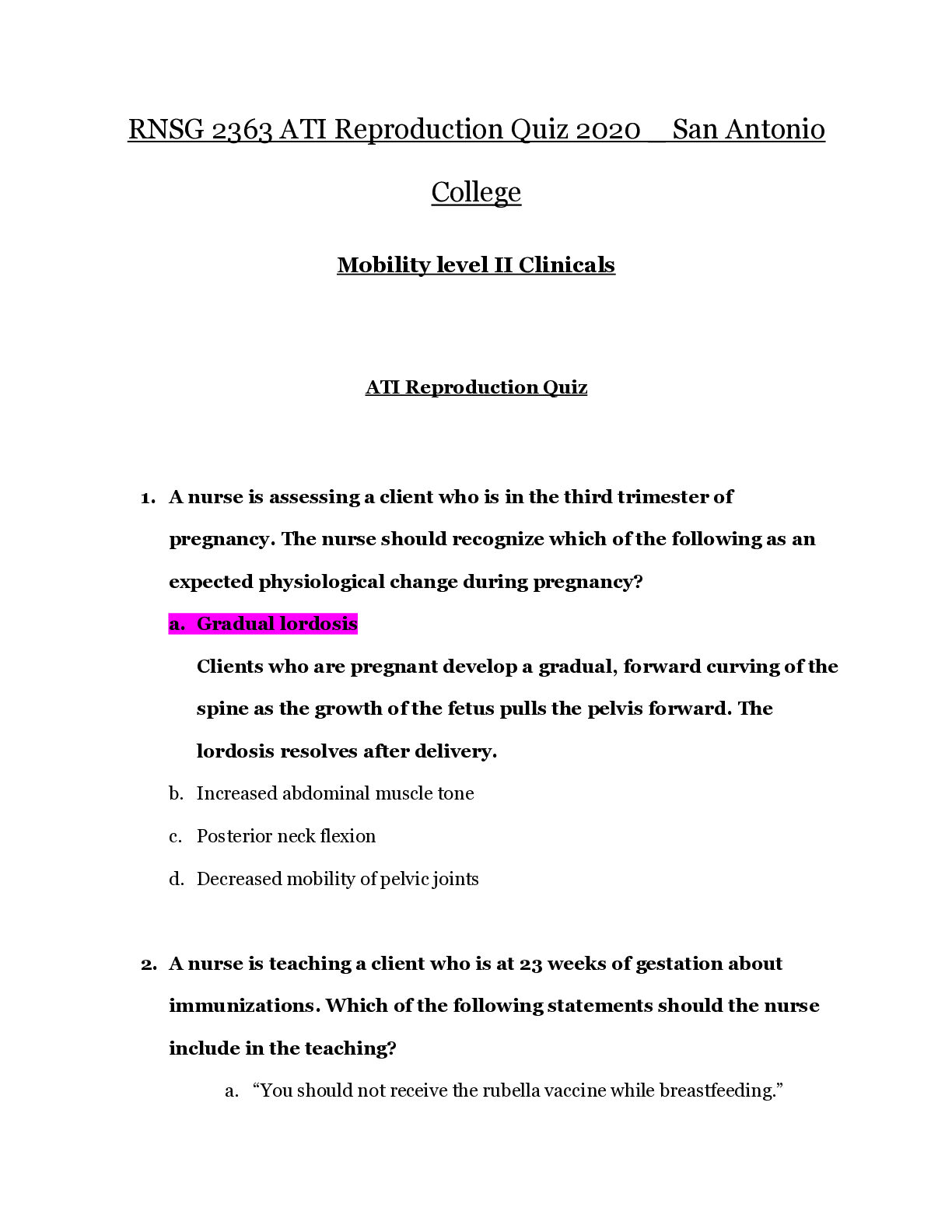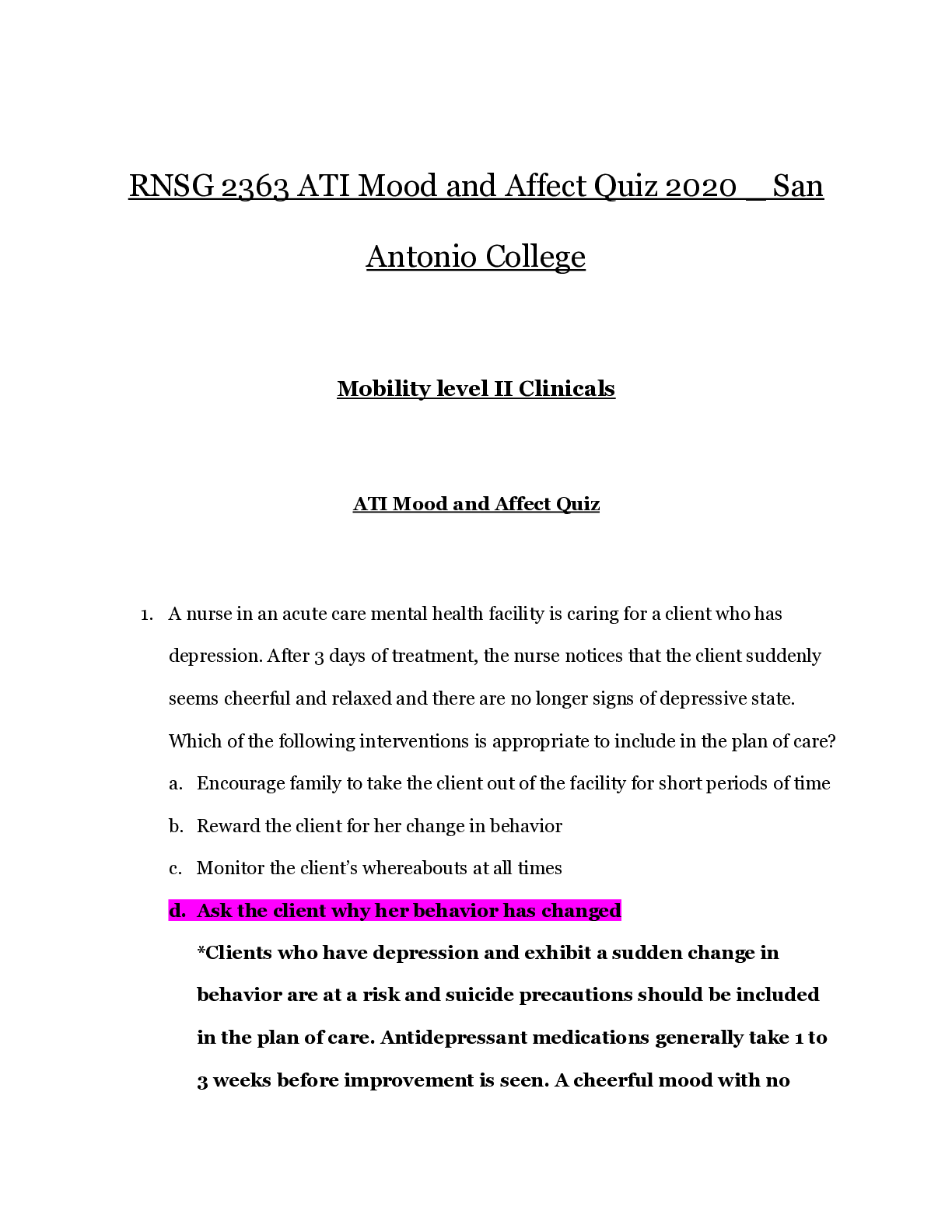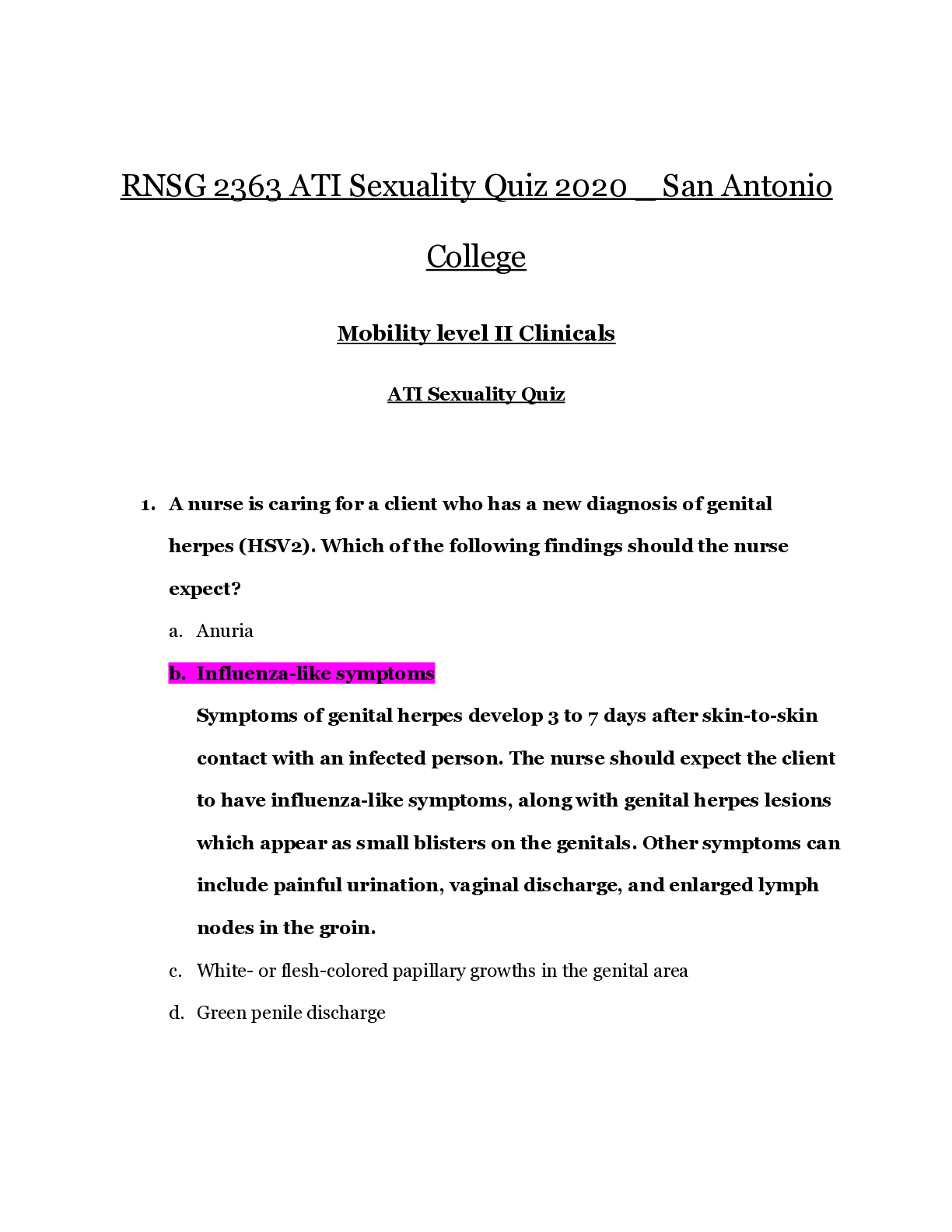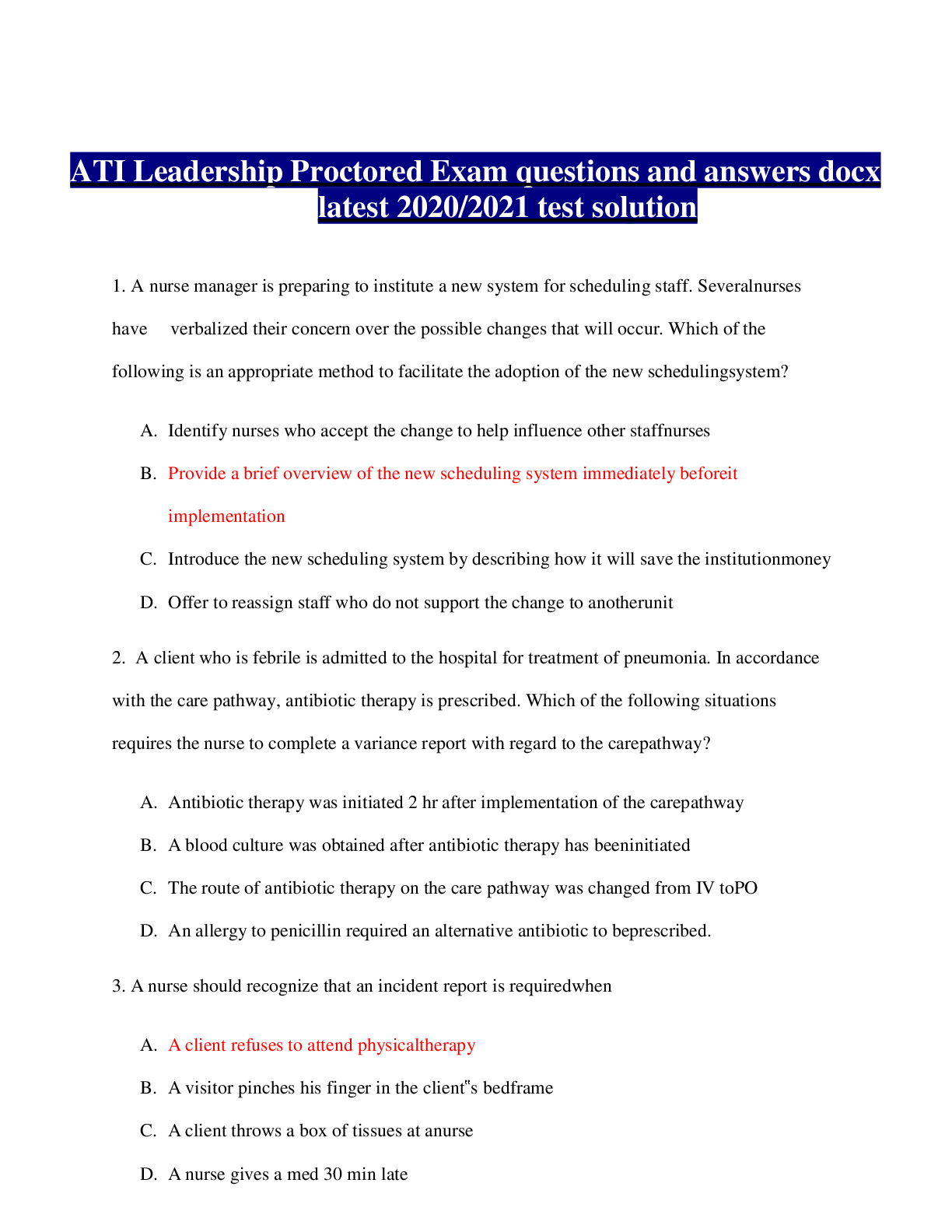*NURSING > QUESTIONS and ANSWERS > RNSG 1538 ATI Concept Base 3 | San Antonio College | ATI Complete solution Guide | 89 GENERAL PRINC (All)
RNSG 1538 ATI Concept Base 3 | San Antonio College | ATI Complete solution Guide | 89 GENERAL PRINCIPLES OF CANCER | 43 PAGES
Document Content and Description Below
ATI Concept Base 3. Cellular Regulation: Ch. 89 General Principles of Cancer Risk Factors: ● Age; older higher risk ● Race ● Genetics ● Exposure to chemicals, tobacco & alcohol ● High fat, r... ed meat, & low fiber ● Exposure to sun, UV, & radiation Staging ● T: tumor higher number bigger tumor ● N: node # of lymph nodes involved ● M: Metastasis: 0 no evidence 1 evidence Risk for malnutrition ● Hypermetabolic state due to presence of carcinoma ● Impair ability to ingest, digest, absorb nutrients Ch. 90 Cancer Screening & Diagnostic Procedures C: change in bowel or bladder habits A sore that doesn’t heal Unusual bleeding or discharge Thickening or lump of breast or elsewhere Indigestion or difficulty swallowing Obvious changes in warts or moles Nagging cough or hoarseness Diagnostics: ● Biopsy provides definitive diagnosis ● Imaging secondary tool; CT, MRI, PET scan, or ultrasound Ch. 91 Cancer Treatment Options ● Remove tumor: tumor excision ● Chemotherapy: damages cell’s DNA or destroys rapidly dividing cells ○ Unintentional harm to normal rapidly proliferating cells ■ Hair, mucous membranes in GI, & bone marrow ○ Implanted port or central catheter ■ High risk for infection Protect & teach ■ Monitor VS temp 100F reported right away & WBC <1000 Neutropenic precautions ● Colony stimulating production ● Avoid crowds,, changing litter box,, avoid yard work & gardening, avoid room temp drinks sitting for more than 1 hr, ● Dishes washed in hot soapy water in dishwasher ● Toothbrushes washed daily don’t share personal items ● Avoid food containing bacteria fresh fruits & vegetable, undercooked meat, fish & eggs, pepper & paprika ○ Administer antiemetic meds ■ Prior, during, afterwards ■ Smells or supplies triggering nausea remove from room ■ Meds to improve appetite & mouth care prior to meals ■ Avoid drinking liquids while eating, inbetween, ○ High protein high calorie & nutrient dense diet & supplement ○ Alopecia ■ 7-10 after initiation to chemo ○ Mucositis: inflammation of tissues in mouth ■ Avoid glycerin based mouthwash or mouth swabs ■ Non alcoholic anesthetic mouthwashes recommended ■ Avoid salty acidic or spicy foods ■ Offer oral hygiene before & after meals ■ Moisturizing agent to counteract dry mouth ■ Use half saline half peroxide rise 2x a week ■ Soft bristled toothbrush ■ Diet bland & soft ○ Anemia & Thrombocytopenia ■ Monitor for s/s: fatigue, pallor, SOB ■ Provide frequent rest periods ■ Administer Epoetin alfa & ferrous sulfate = improve iron levels ■ Monitor for blood in stool, urine, & vomit ■ Monitor for petechiae, ecchymosis, bleeding of gums, nosebleeds ■ Avoid IV, injections taking blood if so apply pressure 10mins ■ Encourage electric razor ■ Soft bristled toothbrush ■ Avoid blowing nose vigorously ■ Administer thrombopoietic meds OPRELVEKIN ■ Avoid NSAIDs and prevent injury ● Radiation Therapy: ○ Skin marked with tattoos to help guide positioning of external radiation ○ Skin care ■ Gently wash skin mild soap & water ■ DON’T apply powder, ointment, lotion, perfumes, deodorant ■ Soft clothing avoid tight and constricted ■ No sun or heat source of site ● Hormonal therapy: ○ Estrogen dependent cancer ○ Tamoxifen ● Immunotherapy ○ Interleukins & interferons Ch. 92 Cancer Disorders ❖ Skin cancer ➢ Leading cause: sunlight exposure ■ Squamous cell cancer rough scaly type lesion ■ Basal cell cancer small waxy nodule most common ■ Melanoma: cancer of melanocytes ➢ ABCDE: asymmetry, border, color, diameter, evolving ➢ s/s: irregular shape & border w/ multiple colors, new moles or change in existing moe, itching, cracks, ulceration, & bleeding (possible) ➢ Treatment: liquid nitrogen to freeze it, topical chemotherapy 5 fluorouracil cream ➢ Prevention: limit exposure to sunlight, apply sunscreen, use sunblock, avoid indoor tanning, wear protective clothing ❖ Leukemia: ➢ Cancer of WBCs; invade and destroy bone marrow, overgrowth of leukemic cells prevents growth of other blood components such as platelets and RBC ■ Risk for infection & bleeding ❖ Lymphoma: ➢ Cancer of lymphocytes ❖ Nursing care: no fresh fruits & vegetables, no visitors who are sick, prevent injury ❖ Treatment: Chemo, radiatio, bone marrow transplant ➢ Report manifestations of infections or illness immediately to provider ➢ The nurse should instruct the client to wash drinking glasses after each use to remove bacteria, which can be harmful to a client who is immunocompromised. ❖ Thyroid cancer ➢ Risk factors: females, diet low in iodine, radiation exposure ➢ Assessment: change in shape or size warning sign & palpable nodules ➢ Nursing care: airway patency, swallowing assessment ➢ Treatment: thyroidectomy, radioactive iodine ❖ Lung Cancer ➢ Prognosis poor diagnosed in advanced stage ➢ Risk factors: smoking biggest risk factor ➢ S/S: cough, dyspnea, hoarseness ➢ Calculate pack yr history ■ # of packs per days X years they smokes = pack year ■ Evaluate use of pipes, chewing tobacco, & cigars ❖ Colorectal cancer ➢ Polyp benign and left untreated becomes cancerous ➢ Key symptom: blood in stool ➢ Colonoscopy screening start at age 50 be done every 10 yrs, unless found polyps ➢ Annual fecal occult blood testing FOBT 50-75 yrs ❖ Breast cancer ➢ Risk factors: relative, early menarche (early/late periods/menopause), prolonged use of oral contraceptives, smoking, Hormone replacement therapy, obesity ➢ Assessment: skin changes (orange peel), dimpling, small firm non-tender, non-mobile bumps, nipple discharge, nipple retraction or ulceration ➢ Treatment: hormone therapy ■ Medications: SERMs tamoxifen & raloxifen ■ chemo/radiation ■ Surgical interventions ➢ Nursing care: ■ Wear sling while ambulating ■ Avoid administrating injections, taking BP, or obtaining blood from affected extremity ■ Early arm & hand exercises to regain full range of motion ■ Don’t wear constrictive clothing ❖ Cervical cancer ➢ Infection with HPV ➢ Prevention: vaccinated with HPV vaccines, ➢ PAP screening should occur by 21 yrs of age or three yrs. Following first sexual intercourse ❖ Prostate cancer ➢ Risk factors: African Americans, high fat diet, ➢ S/S: urinary hesitancy, bladder infections, urinary retention, blood in urine, residual urine after voiding ➢ Assessment: PSA, digital rectal exam, PSA first before rectal, ■ Elevation more than 4 ➢ Prostate screening after age 50 ➢ Meds: leuprolide luteinizing hormone releasing hormone Ch. 93 Pain Management for Clients Who Have Cancer Palliative care: manage pain levels & improve symptoms ● More comfortable ● Meds: nonopioids, opioids, antidepressants & anticonvulsant neuropathic pain relieve, steroids, skeletal muscle relaxers, systemic anesthetic PCA pump, topical local anesthetics, regional nerve blocks ● TENS, imagery, application of hot or cold, hypnosis, acupuncture Hospice care: end of life Ch. 40 Nursing Care of Children Blood Neoplasm Leukemia: causes of production of immature WBC Most common form of cancer in childhood Causes: anemia, thrombocytopenia, neutropenia, immature WBC Diagnosis: ● bone marrow aspiration or biopsy, provide topical anesthetic 1 hr prior to procedure ● CSF analysis ● Lumbar puncture: empty bladder, topical 1 hr cream, side lying, head flexed and knees towards chest ● After procedure lay flat 4-8 hrs. Mucosal ulceration prevention ● Soft-bristled toothbrush ● Lubricate lip balm ● Soft bland diet ● Don’t use viscous lidocaine, hydrogen peroxide, lemon glycerin swabs, & milk of magnesia, avoid rectal temp Immunity CHAPTER 2 Emergency Nrsg. Principles & Mgmt Triage Classes I. RED-emergent II. YELLOW-urgent III. GREEN-non-urgent IV. BLACK-expectant Priority framework ABCDE principle ● Airway ● Breathing ● Circulation ● Disability (LOC, coma) ● Exposure Head lift chin tilt maneuver DON’T use w/ pts who have fractures in their cervical spine!!! Accidental poisoning TX: ● Activated charcoal ● Gastric lavage ● Whole bowel irrigation Don’t induce vomiting! Don’t give Ipecac (This was an old standard no longer doing this) RAPID RESPONSE—-> If patient rapidly declining Cardiac emergencies ● V fib ● V tach Initiate BLS & CPR, IVs ○ TX’s ■ Epinephrine ■ Amiodarone ■ Lidocaine ■ Mg+ ■ Procainamide ■ Vasopressin ■ Dobutamine (Beta1, increased HR, for HF) KNOW YOUR RECEPTORS!!!! (It helps with figuring out side effects!) ACTIVATION CAUSES…. ● ALPHA 1 (skin, mucous membranes, and blood vessels to constrict. Increases BP ● BETA 1 (heart) & BETA 2 (Lungs) ● DOPAMINE- (shock & HF)-Renal blood vessels dilate. Ch. 5 Anaphylactic reaction A life‑threatening, immediate allergic reaction that causes respiratory distress, severe bronchospasm, laryngeal edema, a quick drop in blood pressure, as well as cardiovascular collapse. NURSING CONSIDERATIONS: Treat with epinephrine, bronchodilators, and antihistamines. Provide respiratory support, and inform the provider The nurse should instruct the client to first remove the activation cap from the epinephrine injector. The client should then forcefully insert the injector into the outer aspect of the thigh and hold the epinephrine injector in place for 10 seconds. Following the removal of the injector, the client should massage the injection site for 10 seconds. Finally, the client should ensure that the needle is projecting through the tip of the device. This indicates the medication was injected. Following examination of the pen, the client should seek immediate medical attention, because the therapeutic effects of the epinephrine injector begin to subside within 10 to 20 min. CHAPTER 10 MULTIPLE SCLEROSIS (& other Autoimmune disorders, ALS, Myasthenia Gravis) PATHO ● plaque in the white matter of the CNS turn damages the myelin sheath which interferes with impulse transmission between the CNS and the rest of the body disease there's no known cure ● it usually afflicts people between the ages of 20 and 40 and mostly women ● the normal course for MS is periods of relapsing and periods of remitting and different things can cause Triggers Viruses, cold climate, physical injuries stress, pregnancy, fatigue, hot baths & shower S/S key symptoms ● Diplopia (double vision) ● Decreased visual acuity ● Tinnitus, decreased hearing acuity ● Dysphasia ● Slurred and nasal speech ● or difficulty swallowing they may ● have a slurred and nasal speech ● muscle spasticity ● Muscle weakness these are really Also may have: nystagmus (rapid mov’t of the eyes) bowel dysfunction urinary incontinence some cognitive changes such as impaired judgment & memory loss sexual dysfunction it's important to know kind of those eye symptoms that your symptoms the swallowing the muscle spasticity the incontinence those are kind of all symptoms of MS in terms of W/ Dx procedures an MRI for a pt will reveal plaques in the brain and the spine and that's one way to Dx MS nursing care MEDs ● cyclosporine which is an immunosuppressive agent and that helps reduce the frequency of relapses in ● prednisone- a steroid which helps decrease inflammation in acute exacerbation ● muscle relaxer-two of the main ones I would know are dantrolene and baclofen, used Tx muscle spasticity in ms ALS A degenerative neurological disorder of the upper & lower lower motor neuron. It basically causes progressive paralysis it usually starts in the extremity & it kind of moves up towards the center of the body it ultimately affects the respiratory muscles which causes respiratory failure & eventually death Death usually occurs via respiratory failure w/in 3 to 5 years of the onset of symptoms. The cause of ALS is unknown there is no cure S/s ● muscle weakness ● muscle atrophy ● Dysphagia Important-keep a patent Airway!! suctioning & intubating PRN-will likely need to happen towards the end of the course of ALS. -pneumonia is a big one and then respiratory failure due to the weakness of the respiratory muscles MEDS ● glutamate antagonist which can help the deterioration of the motor neurons in terms of complications. CHAPTER 23 TB TB is an infectious disease caused by Mycobacterium, that primarily affects the lung parenchyma associated w/ poverty, malnutrition, overcrowding, substandard housing, and inadequate health care.. -transmitted by AIRBORNE, so anytime you suspect that somebody may have TB you want to put them into a negative airflow room right away and you want to wear your n95 mask anytime you go in that room so if you have a patient with TB there's a good chance their family members may have TB too so they will also need to be tested PATHO The bacteria are transmitted through the airways to the alveoli, where they are deposited and begin to multiply. The bacilli also are transported via the lymph system and bloodstream to other parts of the body (kidneys, bones, cerebral cortex) and other areas of the lungs (upper lobes). The body’s immune system responds by initiating an inflammatory reaction. Phagocytes (neutrophils and macrophages) engulf many of the bacteria, and TB-specific lymphocytes lyse (destroy) the bacilli and normal tissue. This tissue reaction results in the accumulation of exudate in the alveoli, causing bronchopneumonia. The initial infection usually occurs 2 to 10 weeks after exposure. RISK FACTORS ● a crowded environment such as a prison or a long-term care facility ● low socioeconomic status ● immunocompromised individuals will also be at higher risk for TB, so if they have HIV or they're receiving chemotherapy and their immune system is compromised ● Being a health care worker performing high-risk activities ● Institutionalization (e.g., long-term care facilities, psychiatric institutions, prisons). ● Pre Existing medical conditions or special treatment (e.g., diabetes, chronic kidney injury, malnourishment, selected malignancies, hemodialysis, transplanted organ, gastrectomy, and jejunoileal bypass). [Show More]
Last updated: 1 year ago
Preview 1 out of 43 pages
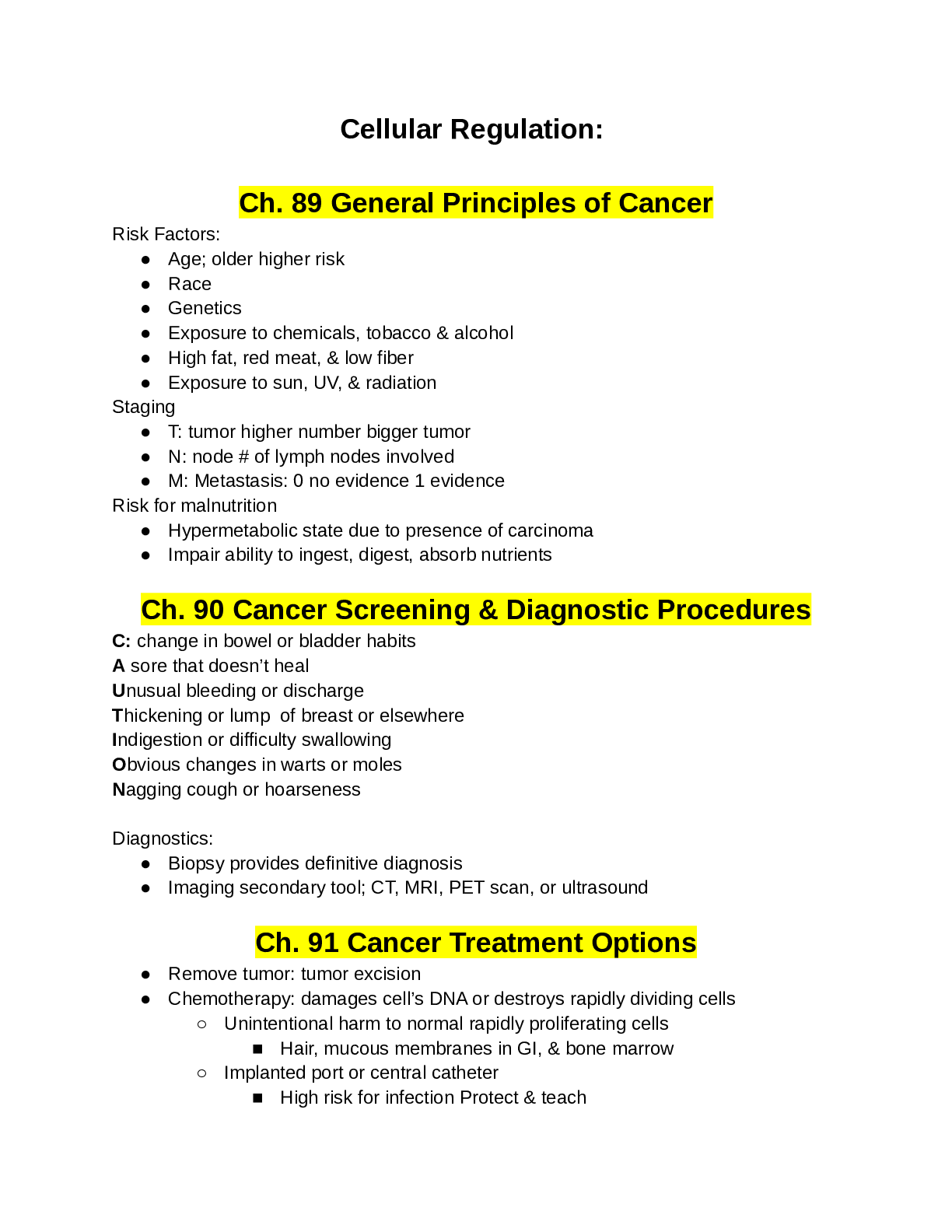
Reviews( 0 )
Document information
Connected school, study & course
About the document
Uploaded On
Feb 12, 2021
Number of pages
43
Written in
Additional information
This document has been written for:
Uploaded
Feb 12, 2021
Downloads
0
Views
38

